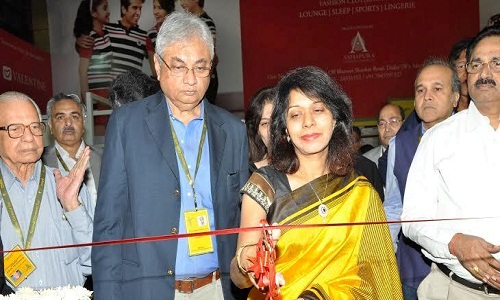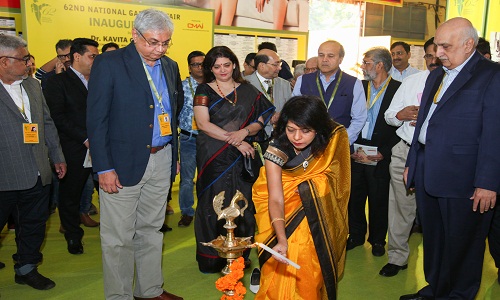FW
Bangladesh’s export earnings in December 2015 were the highest monthly exports in history. The expectation is that Bangladesh’s GDP will grow 6.7 per cent in 2016, making it one of the world’s fastest growing economies.
Bangladesh is the world’s second largest clothing exporter, behind only China. It exports the majority of that clothing to the European Union and the US, and business has been good of late. US imports of apparel from Bangladesh, for instance, increased about 16 per cent from November 2014 to November 2015.
Clothing has made up an ever larger share of Bangladesh’s total exports for years, reaching about 81.7 per cent last year. One reason for the country’s success is that there is an insatiable global demand for cheap clothes. And Bangladesh produces a lot of these. In fact this segment seems to be the country’s specialty.
But there are concerns. The country needs to diversify its exports and should start moving up the value chain into higher end products if it really wants to develop. One challenge can come from Vietnam. This has become another top location for apparel manufacturing. If the Trans-Pacific Partnership trade deal goes through, Vietnam can become an even more attractive spot for sourcing, especially for US brands.
"At the interactive session with Gupta, she explained the challenges in front of the sector. “We take everything seeming as a threat as a great opportunity. All I can say is the time is crucial for us to introduce measures promoting growth in the textile sector since our share is still restricted to a small figure in the global textile business. Tragically, we are losing out to Vietnam and other Asian peers. Urgent actions are required to seize the opportunities lying untapped and make ‘Make in India’ campaign successful,” she explained. The aim is not to keep growth limited to some particular areas but to bring it in across all categories in the textile sector ranging from fiber to fashion."

The 62nd NGF organized by the Clothing Manufacturers Association of India (CMAI) from January 27 to 28 at the Bombay Exhibition Centre, Mumbai, was a huge success. The two-day fair that offered various business opportunities for the apparel sector attracted a large number of visitors and industry professionals. With nearly 283 stalls displaying over 330 brands and saw around 15,000 retailers and trade visitors from across the country and overseas visited this B2B fair.

Kavita Gupta, Textile Commissioner was the chief guest at the inaugural event of the fair. The fair was divided into three sections: men’s, women’s and kids’. Speaking at inauguration Gupta said the Textile Ministry is determined to promote the garment sector in every possible way. “The sector is going to be a highly focused area for the Ministry, considering the potential it manifests. A lot of value additions have become a part of the sector in recent days and many are lined up for further. We are also trying to ensure maximum benefits for the garment segment once GST gets implemented.” Stressing on the commitment to the sector, she said while other segments have got not more than 10 per cent subsidy, the garment sector has been given about 50 per cent subsidy. Efforts have also been made to maintain transparency and flawless mechanism. “We also consider branding important for any segment to grow and this exhibition is the best display of endeavors being made towards this direction,” she opined.

At the interactive session with Gupta, she explained the challenges in front of the sector. “We take everything seeming as a threat as a great opportunity. All I can say is the time is crucial for us to introduce measures promoting growth in the textile sector since our share is still restricted to a small figure in the global textile business. Tragically, we are losing out to Vietnam and other Asian peers. Urgent actions are required to seize the opportunities lying untapped and make ‘Make in India’ campaign successful,” she explained. The aim is not to keep growth limited to some particular areas but to bring it in across all categories in the textile sector ranging from fiber to fashion.
Commenting on branding Gupta said that a brand comes last in the entire value chain. It begins with fiber, then its spinning and fabric and likewise every other segment of the value chain and then comes garmenting. “So the entire value chain requires promotion. Branding is certainly important and we are putting extra emphasis on it with an extra focus on its holistic growth,” she opined. Value additions too are critical for growth of the entire value chain, to ensure that fabrics have not been imported but are available easily in the domestic markets, to establish self-sufficiency. She observed that India is doing extremely well on this front. “We are developing some good fabrics in viscose, in synthetic and many other fibers,” she informed.
Meanwhile the government too is promoting viscose. In its effort to speed up growth the government is providing interest submission on viscose products. “We are aiming at export to the tune of $40 billion. We are still lagging behind in technical textile so its promotion is another focus area. We are witnessing 13 per cent growth in this segment, but may go up soon to 20 per cent.”
"Textiles minister Santosh Kumar Gangwar released ‘Baseline survey on Technical Textiles’ and BIS Standards at a curtain raiser event held at New Delhi for Technotex 2016, India’s premier show on technical textiles. The show will be held at Bombay Exhibition Centre, Goregaon, Mumbai from April 21 to 23, 2016. The fifthe International Exhibition & Conference on Technical Textiles recognizes the immense potential of technical textiles and its increasingly diverse and innovative applications. Fittingly, the event has a smart theme: ‘Technical Textiles Towards a Smart Future."

Textiles minister Santosh Kumar Gangwar released ‘Baseline survey on Technical Textiles’ and BIS Standards at a curtain raiser event held at New Delhi for Technotex 2016, India’s premier show on technical textiles. The show will be held at Bombay Exhibition Centre, Goregaon, Mumbai from April 21 to 23, 2016. The fifth International Exhibition & Conference on Technical Textiles recognizes the immense potential of technical textiles and its increasingly diverse and innovative applications. Fittingly, the event has a smart theme: ‘Technical Textiles Towards a Smart Future.’
Growing importance of technical textiles

Speaking at the curtain raiser event, Gangwar said that technical textiles can play an important role in the nation’s social and economic fronts. Gangwar recalled the launch of Rs 427 crores government scheme to promote usage of geotechnical textiles in the Northeastern region of India, in March 2015. He said that this scheme would provide support for use of geotextiles in road construction, slope stabilization and water reservoirs. He expressed satisfaction at the completion of the construction of the airport access road at Imphal, using geotextiles. He said that approval has been given for 13 water reservoir projects in Manipur and Tripura, and for two projects in road construction and slope stabilization in the two states, all employing geotextiles.
The minister also said that the Technology Mission on Technical Textiles (TMTT) has been extended for two years, i.e., for 2015 -2016 and 2016 2017. Eight Centres of Excellence have been set up under the scheme, where facilities for testing, R&D and skill development in technical textiles are being set up. Gangwar said that TMTT Mission II provides support in the areas such as export market development of technical textiles, new business start-ups, contract research and market development support for sale to institutional buyers, among others. He noted that a special focus has been given to technical textiles, under Amended TUFS; a capital subsidy of 15 per cent has been provided for technical textile machinery under the amended scheme, said the Minister.

On the occasion, the Gangawar released the Baseline survey on Technical Textiles and BIS Standards for the industry. The release of the survey and standards is an important step forward in the government’s efforts for standardization of technical textile products in India. The minister also released the event brochure for Technotex 2016.
The event is organized by the government of India, in association with Federation of Indian Chambers of Commerce & Industry (FICCI) to make India a manufacturing hub in the area of technical textiles under the Make in India initiative of government.
The knitwear industry in Pakistan has been unable to realise its full potential. Pakistan’s share in world knitwear exports has been declining since 2005. During July to December 2015, Pakistan’s exports of knitwear declined by around three per cent in dollar terms as compared to the previous year. However exports went up by three per cent in quantity terms.
Global demand for knitwear is rather weak. When global demand for any product is weak, the only option left is to go in for value addition since value-added products can maintain and fetch higher prices. Knitwear firms in developing countries may upgrade either their processes or products or upgrade to other functions such as design, logistics, branding and marketing.
By entering global value chains, Pakistan’s knitwear firms can improve their processes. Although process upgrading enables firms to survive in the export market, it does not help them to attain value added functions. Making a higher value added product is known as product upgrading. But only a handful of firms manage to produce slightly higher value added products.
Although designing is a high value added function, developing countries’ suppliers cannot attain this capability with ease since they cannot compete with designers of developed countries.
For better cotton products, BCI plans to implement the final initiative to end-to-end online traceability. In January 2016, BCI added garment manufacturers to its traceability system, the Better Cotton Tracer. This new addition implies a smooth assistance to BCI in order to ensure volumes of Better Cotton being sourced by its retailers and brands through products and suppliers from field to store.
Started in 2013, the operational Better Cotton Tracer initially comprised of ginners, traders, spinners, and retailers and brands providing access to the Tracer. With the course of time, the system has accommodated fabric mills, import-export companies, traders of yarns and fabrics, and garment manufacturers finally; so that each aspect in the supply chain can record their transactions accordingly.
The BCI Supply Chain Manager, Kerem Saral acknowledged the dynamic and comfortable use of the Better Cotton Tracer, being one of the end-to-end traceability system of its kind in the cotton industry which has facilitated the supply chain across regions easily. The End-to-end traceability makes the administrative comprehensive, particularly for retailer and brand members who drive Better Cotton uptake.
How much Better Cotton is sourced by any user in the supply chain can easily be determined by the Better Cotton Tracer. The amount of Better Cotton Claim Units (BCCUs) are recorded by the supply chain units as they receive against a product and allocate these to product sold, so that the amount that is allocated does not exceed the amount of received. Although BCI’s current system does not physically trace Better Cotton through the supply chain, end-to-end traceability strengthens the credibility of Better Cotton claims made by the retailer and brand members.
With the prevailing unstable market conditions, the 2015-16 fiscal has been one of the most demanding year for the synthetic and rayon textile exporters feels Anil Rajvanshi, Chairman, Synthetic & Rayon Textiles Export Promotion Council (SRTEPC). At a recent SRTEPC export award function, he said there has been a dip in exports of synthetic and rayon textiles by 6 per cent. Consequently prices have also declined. On foreign trade policy, SRTEPC cshairman said that with the intervention of Textile Ministry many synthetic and rayon textile items have been included in the Merchandise Exports from India Scheme (MEIS). He underlined the need to introduce new policies to improve structural efficiency.
One excise duty on man made fibres, the SRTEPC chairman said, the textile Ministry along with the support of the council is seeking to prevail upon the Finance Ministry to reduce duty from 12 to 6 per cent in the forthcoming Union Budget. Also, there is a need for the authorities to realise that man made fibre industry makes up 70 per cent share of the global market while the balance 30 per cent is with cotton. And for the overall Indian textile industry’s progress, encouragement of the man-made industry is a must.
He also highlighted the importance of man-made textile industry stating its relevance in achieving the government’s target of making Indian textile industry worth $300 billion from the current $110 billion.
Invista’s fabric brand Cordura is known for innovative textile developments. Cordura Combat Wool fabric offers the comfort and aesthetics of wool combined with the durability of nylon. Super light-weight Cordura Ultra Lite fabrics have outer layer apparel applications.
The brand’s focus on industry trend indicators helps prompt the creation of fashionable, functional fabrics, built to last. Whether one is in the office, at the gym, or trekking through the jungle, Cordura fabrics are designed to offer best-in-class durable functionality. These fabrics are aimed at hitting the crossover trend sweet spot to help today’s designers.
High stretch knits powered by durable Cordura fiber technology offer multifunctional solutions for gym and swimwear inspired designs. Cordura fabrics in the athleisure category offer durable comfortable functionality for those who favor active on-the-go lifestyle.
The brand offers powerful street smart knits with Cordura fiber technology and wear resistant Cordura Denim and Canvas fabrics with integral stretch. Cordura Ultra Lite ripstop fabric combines strength, durability and water resistance into an ultra-thin, ultra-light barrier solution. This fabric technology is ideal for a variety of end-use applications where optimal strength-to-weight ratio is critical. Cordura fabrics have applications in bags, packs and footwear.
www.cordura.com/
Kelheim Fibers, a leading manufacturer of viscose specialty fibers, is incorporating IR-reflecting particles into fibers. Different levels of these particles were integrated into the fiber’s core, thereby preserving the fiber’s inherent properties, rather than being added as a topical finish using additives based on titanium oxide or other metal-based compounds.
Visible light is reflected by 90 to 95 per cent, while in the near infrared range, a reflectance of up to 90 per cent is reached, depending on the wavelength spectrum. This proves a clear benefit in the reflectance of direct sunlight, where the fiber is capable of providing a cooling effect, for example, by protecting the human body from outside radiation.
At the same time, the fiber may also be used in warming applications, where the thermal radiation emitted from the body is reflected by these particles back to the body, reducing the cooling effect and keeping the person warm. In the mid IR-range an increase of reflectance of about 20 per cent of m-IR radiation was achieved in tests compared to normal viscose.
The fiber can be used for both textile and nonwoven processes, where the fabric can either protect against outside influences or reflect the IR-radiation back to the inside source.
www.kelheim-fibres.com/
A Rs 108 crores integrated textile park is coming up in Vidarbha at Hinganghat in Wardha district. This is expected to generate at least 1,000 jobs and provide the much needed fillip to the cotton economy of the region.
Cotton is the main cash crop of Vidarbha. But the cotton belt is under distress due to the uncertainty over prices and the inability to process raw cotton up to the textile and garment stages to spur demand. For some reason textile units did not come up in the region, and the cotton produced here was transported to far off south India or western Maharashtra, while farmers growing it always got a raw deal.
Hinganghat Integrated Textile Park has an authorised share capital of Rs 180,000,000 with a paid up capital of Rs 59,500,000.
The plan is to set up 11 units in the integrated park spread over 32.63 acres. Of them one each will be for ginning, twisting/doubling, knitting, processing, fiber-yarn dyeing, garmenting, technical textiles and two each for spinning and weaving.
About 40 per cent funding (with a cap of Rs 40 crores) is provided by the Center and the state government’s share is nine per cent or Rs 9 crores maximum.
Home textile player GHCL will launch its own brand next fiscal. This will be a private retail brand for home decor and lifestyle products. It will be targeted at the domestic market and is likely to be pitched against other home textile brands like Bombay Dyeing and Welspun.
GHCL already has a tie-up with Perry Ellis International for the brand Laundry by Shellie Segal for bedding products which include flat sheets, sheet sets, duvet covers and coordinating shams for customers in the US and Canada.
The total turnover of GHCL for 2014-15 was around Rs 2,400 crores, which it anticipates to grow to around Rs 2,500 crores in 2015-16. Of the total turnover, the textile segment contributes around 40 per cent. The textile division is a vertically integrated manufacturing facility with spinning, wide width weaving, continuous fabric processing and cut and sew facilities for manufacturing premium quality bed linen.
The spinning unit is located near Madurai in Tamil Nadu while its home textile manufacturing is located near Vapi in Gujarat. In time GHCL wants to gradually build its own brands in the domestic market, thereby creating a niche place for its products.
ghcl.co.in/












